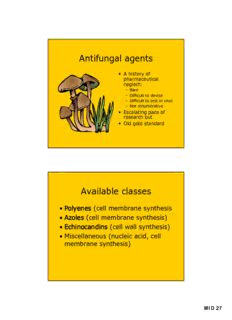
Antifungal agents Available classes PDF
Preview Antifungal agents Available classes
Antifungal agents • A history of pharmaceutical neglect: – Rare – Difficult to devise – Difficult to test in vitro – Not renumerative • Escalating pace of research but • Old gold standard Available classes • Polyenes (cell membrane synthesis • Azoles (cell membrane synthesis) • Echinocandins (cell wall synthesis) • Miscellaneous (nucleic acid, cell membrane synthesis) MID 27 1. Polyenes • First antifungal antibiotics • Isolated from Streptomyces spp. • General structure: –Polyenes (multiple conjugated double bonds) –Macrolides (large rings with lactone linkage) Polyene structure Lipophilic, hydrophobic, hydrophilic, amphipathic, amphoteric MID 27 Polyene mechanism of action • Macrolide ring inserts into membrane parallel to phospholipid chains, binding to sterols • Cylindrical channels form • Cations, then macromolecules leak out • Cell dies Polyene action MID 27 Polyene resistance • Most clinically important fungi sensitive • Dermatophytes resistant • Inducible resistance rare (old drugs still work) • Inherent resistance due to deminished membrane ergosterol with less affinity for drug Polyenes: Nystatin • 1950 in NYState • Topical administration only • Too toxic for systemic administration • Uses: –Skin and mucosal candida infection especially oral thrush. No effect on dermatophtyes MID 27 Amphotericin B • 1954 from Venezuela • Not soluble in water at physiologic pH • Not orally absorbed • Occasional oral use of suspension for “topical” treatment of oral or esophageal candidiasis • IV use: gold standard of antifungals Amphotericin B • Colloidal dispersion in deoxycholate (bile salt) • Protein bound. Urine and CSF concentrations low. Tissue stores slowly released • Significant toxicity: –Infusion-related –Cumulative MID 27 Infusion-related AmB toxicity • Dramatic infusion-related fever, chills, nausea, vomiting, diarrhea, dyspnea • ?cytokine/prostaglandin related • Treatment: symptomatic premedication – Acetaminophen – Benadryl – Cortisone – Demerol – ?Duration of infusion Cumulative AmB toxicity • Renal: characteristic cation-wasting nephropathy days-weeks into treatment. Low K+, Mg++, elevated creatinine. Treatment-limiting. (vasoconstriction, tubular cell lysis) • Hematologic: characteristic normocytic anemia (direct marrow toxicity /renal) MID 27 Amphotericin B uses • Systemic fungal diseases caused by –Yeasts (candidiasis, cryptococcosis) –Molds (aspergillosis, mucormycosis) –Dimorphs (histo, blasto, cocci) • Toxicity has shaped usage patterns Amphotericin B modifications • Drug encased in • Liposomal liposomes or • Lipid complex otherwise highly • Colloidal lipid associated has less toxicity dispersion and equivalent efficacy • Used in confirmed • Mechanism disease unclear (?direct • $$$ delivery by macrophages) MID 27 2. Azoles • 1970s to present • From topical to powerful oral and IV drugs • Imidazoles: 2N in 5-membered ring • Triazoles: 3N in 5-membered ring Azole structures • Fluconazole: bis- triazole • Ketoconazole: imidazole MID 27 Azole mechanism of action (and toxicity) • Inhibit fungal cytochrome P450 enzymes which demethylate lanosterol to ergosterol –Block formation of ergosterol –Cause accumulation of toxic alpha-14 methyl esters in fungal cell –Sabotage membrane integrity • “Fungistatic” Toxicity of Azoles • inhibit cholesterol-dependent steroid hormone synthesis (testosterone; cortisol) • Lead to ccumulation of metabolites with aldosterone-like effects • Interfere with metabolism of other cytochrome P450 metabolized drugs MID 27 Resistance to Azoles • Intrinsic, esp. nonalbicans Candida • Inducible rare, but increasing with increasing use –Alteration in P450 enzymes –Membrane lipid changes with decreased permeability Older Azoles • Clotrimazole • Topical only (Mycelex, • Minimal toxicity Desenex, • Used for Lotrimin, Gyne- dermatophyte lotrimin) and mucosal • Miconazole candidal (Monistat) infections • Terconazole (Terazol) MID 27
Description: